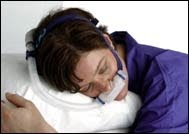 All week long the Sleep Education Blog has been counting down the top stories of 2010. This year viral video content was king, with an unlikely - and unconscious - Englishman taking the spotlight.
All week long the Sleep Education Blog has been counting down the top stories of 2010. This year viral video content was king, with an unlikely - and unconscious - Englishman taking the spotlight.5. Tart Cherry Juice Won’t Cure Insomnia (July 14)
A widely reported pilot study involving tart cherries was the subject of controversy within the sleep community last summer. Most headlines claimed tart cherry juice could outright cure insomnia, but in reality the beverage isn’t a magic bullet for sleep. If you read the full study you’ll find that you may see slight improvements, similar to valerian or melatonin supplements.
4. Fatal Familial Insomnia: A Genetic Death Sentence (April 28)
A National Geographic special put the world’s rarest sleep disorder in the spotlight last spring. Fatal Familial Insomnia is a prion disease caused by a genetic mutation carried by only about 40 families in the world. At advanced stages of the disease, the boundary blurs between sleep and wakefulness. A person can live for months or years in this stage before dying of the rare disease.
3. The Real Freddy Kreuger, “Nightmare on Elm Street” and Sudden Unexplained Deaths (April 30)
You may not believe it but “A Nightmare on Elm Street” was inspired by a real-life story ripped from the headlines. Director Wes Craven dreamed up Freddy Kreuger after reading about a group of Cambodian refugees who all refused to sleep after sharing terrifying nightmares of a single boogeyman. Each refugee ended up dying in their sleep a short time later. On a side note, this blog post inspired some unusual comments from horror movie fans.
2. Tips for Sweet Slumber in the Summer (May 24)
After no-show last year, summer weather returned in 2010. Sleep problems associated with longer days and hot weather also made a comeback. This guide on how to better your sleep in the summer months proved to be a hit, and hopefully helped some people get better sleep along the way.
1. Sleep Talking Man is the Talk of the Internet (January 16)
This series of viral videos became an internet sensation early in 2010, even ending up on The Today Show. With quotes like "You can't be a pirate if you don't have a beard. I said so. MY boat, MY rules," its clear why the videos were a hit. Though like anything of this nature it could be a hoax.









 Good nighttime sleep at a very early age may help
Good nighttime sleep at a very early age may help 



 Caffeine is a unique substance. Unlike most other stimulants and commonly abused drugs you can’t seriously harm your health by overdoing it. At least, that’s the perception.
Caffeine is a unique substance. Unlike most other stimulants and commonly abused drugs you can’t seriously harm your health by overdoing it. At least, that’s the perception.

 Some people are naturally wired to be tired. About 25 percent of people carry a gene variant that makes them sleepier than their peers, researchers have discovered.
Some people are naturally wired to be tired. About 25 percent of people carry a gene variant that makes them sleepier than their peers, researchers have discovered.







